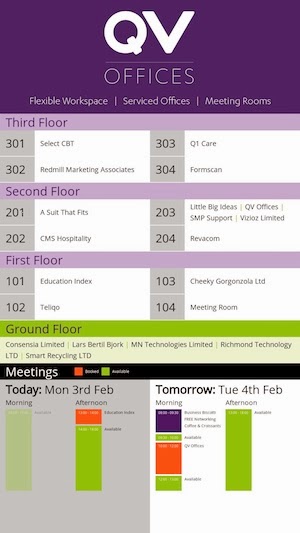Being experts on all things Umbraco, we jumped at the chance to help our client,
QV Offices, with their pressing signage predicament. They needed to display a sign in the entrance to their building and approached us for our advice. Of course it had to be electronic: displaying multiple names of their serviced office clients, meeting room bookings and on-the-pulse promotions. But with a winding Victorian staircase and minimal storage space how could the monitor be run, updated and managed? That’s where we came in…
The Raspberry Pi is then tucked away out of sight in the main electrical cupboard which just happens to be next to the sign, we had an electrician add a power point inside this cupboard to allow us to power the screen and the Raspberry Pi.
Although a room sign was the initial requirement from QV Offices, their medium term goal has always been to add online meeting booking to their website and hence we suggested adding information about the current and next day's meetings to the sign that would be pulled directly from their online booking system.
We produced the design and built the web page to fit exactly on a 1920 x 1080 screen (Full HD in Portrait)
As you would expect all the information can be edited via an Umbraco CMS, they are able to add floors, rooms, clients and virtual clients as well as add meeting bookings to their meeting diary.
We chose to use the Chromium web browser which for those who do not know is the open sourced version of Google Chrome. You can install this from the terminal with the following command:
Installing Unclutter
We found this little application which automatically hides the mouse pointer, it is used in the script below and is installed using the following command:
sudo apt-get install unclutter
Auto start Chromium and disabling the screen saver, power saving and mouse
When the Raspberry Pi has been installed it will not have a keyboard or mouse and hence if their was a power cut we needed it to always boot and re-loaded Chromium with the correct URL.
Our preferred command line text editor is
Nano and I have assumed you know how to use this editor or will be able to work it out pretty quickly.
So using the following command:
sudo nano /etc/xdg/lxsession/LXDE/autostart
We then changed the autostart file content to:
@lxpanel --profile LXDE
@pcmanfm --desktop --profile LXDE
@xscreensaver -no-splash
@xset s off
@xset -dpms
@xset s noblank
@chromium --kiosk --incognito http://www.qvoffices.com/someURL
@unclutter -idle 0
The first few commands turn off the screen saver and power saving, we then open Cromium in Kiosk Mode (full screen with no menu etc) and pass in the URL to use (I have changed the URL in this example) We found a useful blog post with the
Cromium command line switches.
Finally we also open an application called Unclutter which auto hides the mouse after 0 seconds, so you will never see a mouse on the sign.
We also had to edit the following file:
sudo nano /etc/lightdm/lightdm.conf
And added the following line under the [SeatDefault] section:
xserver-command=X -s 0 dpms
Refreshing the screen
We decided to try and add a scheduled task that would trigger Chromium to reload the page, at some point in the future we might well change this to using Javascript to update the content, but for now this works fine.
First we installed the XDOTool which enables you to script Keyboard commands:
sudo apt-get install xdotool
export DISPLAY=":0"
WID=$(xdotool search --onlyvisible --class chromium|head -1)
xdotool windowactivate ${WID}
xdotool key ctrl+F5
This selects the correct display and then sends a CTRL + F5 to refresh Chromium.
You will need to give this file execute permissions:
chmod a=rwx refreshing.sh
Now we have the script file setup we just need to schedule it to call this script periodically which is done by using Crontab, to edit this you use the following command:
And we added the following:
*/5 * * * * DISPLAY=":.0" /home/pi/scripts/refreshing.sh >/home/pi/cronlog.log 2>&1
This calls our script every 5 minutes to refresh the display and it logs any errors to the cronlog.log file.
Summary
QV Offices now have a richer and more manageable booking system than they did before we started, and a great new sign to boot.
